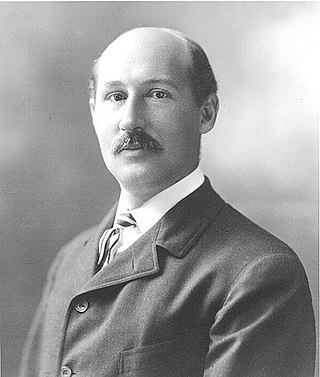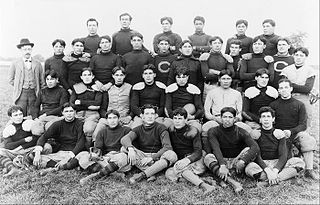Related Research Articles
The Dickinson System was a mathematical point formula that awarded national championships in college football. Devised by University of Illinois economics professor Frank G. Dickinson, the system ranked national teams from 1924 to 1940. The 1924 ratings were made retroactively by Dickinson during the 1925 college football season, the first in which a number 1 team was designated at the end of the season. The retroactive choice on October 16, 1925, for the 1924 season was Notre Dame.

A national championship in the highest level of college football in the United States, currently the NCAA Division I Football Bowl Subdivision (FBS), is a designation awarded annually by various organizations to their selection of the best college football team. Division I FBS football is the only National Collegiate Athletic Association (NCAA) sport for which the NCAA does not host a yearly championship event. As such, it is sometimes referred to as a "mythical national championship".

The 1912 College Football All-America team is composed of college football players who were selected as All-Americans for the 1912 college football season. The only selector for the 1912 season who has been recognized as "official" by the National Collegiate Athletic Association (NCAA) is Walter Camp. Many other sports writers, newspapers, coaches and others also selected All-America teams in 1912. One writer, Louis A. Dougher, published a "Composite Eleven" in the Washington Times which consisted of his aggregating the first-team picks of 23 selectors.

Benjamin Harrison Dibblee was an American college football player and coach. He played halfback for Harvard University from 1896 to 1898, and was a consensus All-American in 1897 and 1898. Dibblee served as the head football coach for Harvard from 1899 to 1900, compiling a 20–1–1. His 1899 team was retroactively recognized as a national champion by a number of selectors.

Frank Hudson was a football player and coach who was a member of the Laguna Pueblo tribe from New Mexico.
The 1927 Yale Bulldogs football team was an American football team that represented Yale University as an independent during the 1927 college football season. The team finished with a 7–1 record, shut out four opponents, and outscored all opponents by a total of 157 to 32. The team was rated as one of the greatest to ever represent Yale. The team included two consensus All-Americans and was retroactively recognized by the Boand System and College Football Researchers Association as the national champion for 1927. The team was ranked No. 5 in the nation in the Dickinson System ratings released in December 1927.

The 1899 Carlisle Indians football team represented the Carlisle Indian Industrial School as an independent during the 1899 college football season. Led by first-year head coach Pop Warner, the Indians compiled a record of 9–2 and outscored opponents 383 to 46.
The 1946 Navy Midshipmen football team represented the United States Naval Academy during the 1946 college football season. With the return Tom Hamilton, head coach from 1936 to 1938, the Midshipmen compiled a 1–8 record and were outscored by their opponents by a combined score of 186 to 105.

The 1897 Army Cadets football team represented the United States Military Academy in the 1897 college football season. In their first season under head coach Herman Koehler, the Cadets compiled a 6–1–1 record and outscored their opponents by a combined total of 194 to 41. The Cadets suffered their only loss against Harvard by a 10 to 0 score and played Yale to a 6–6 tie. The Army–Navy Game was not played in 1897.
The 1965 small college football rankings are rankings of college football teams representing smaller college and university teams during the 1965 college football season, including the 1965 NCAA College Division football season and the 1965 NAIA football season. Separate rankings were published by the Associated Press (AP) and the United Press International (UPI). The AP rankings were selected by a board of sports writers, and the UPI rankings were selected by a board of small-college coaches.
The 1968 small college football rankings are rankings of college football teams representing smaller college and university teams during the 1968 college football season, including the 1968 NCAA College Division football season and the 1968 NAIA football season. Separate rankings were published by the Associated Press (AP) and the United Press International (UPI). The AP rankings were selected by a board of sports writers, and the UPI rankings were selected by a board of small-college coaches.
The 1942 Brown Bears football team represented Brown University during the 1942 college football season.
The 1942 Penn Quakers football team was an American football team that represented the University of Pennsylvania as an independent during the 1942 college football season. In its fifth season under head coach George Munger, the team compiled a 5–3–1 record and outscored opponents by a total of 168 to 72.
The 1939 Penn Quakers football team was an American football team that represented the University of Pennsylvania as an independent during the 1939 college football season. In its second season under head coach George Munger, the team compiled a 4–4 record and was outscored by a total of 98 to 70.
The 1942 Harvard Crimson football team was an American football team that represented Harvard University during the 1942 college football season. In its eighth season under head coach Dick Harlow, the team compiled a 2–6–1 record and was outscored 123-52 by opponents.
The 1946 Harvard Crimson football team was an American football team that represented Harvard University in the Ivy League during the 1946 college football season. In its 10th season under head coach Dick Harlow, the team compiled a 7–2 record and outscored their opponents 214 to 65.
The 1942 Buffalo Bulls football team was an American football team that represented the University of Buffalo as an independent during the 1942 college football season. In their seventh season under head coach Jim Peele, the Bulls compiled a 6–2 record and outscored opponents by a total of 215 to 52.
The 1902 college football season rankings included a ranking by Caspar Whitney for Outing and a top-sixteen rating in The Sun.
The 1900 college football season rankings included a ranking by New York City newspaper The Sun.
The 1908 college football season rankings included a ranking by New York City newspaper The Sun.
References
- 1 2 3 4 5 6 "In the Football World — How the Leading Elevens are Impartially Rated — Harvard, Princeton, Lafayette and the Indians Top the List". The Sun . December 4, 1899. Retrieved January 27, 2024.
With the football season at an end, the critics are busily engaged in reviewing the various big games and in rating the leading elevens according to merit. Impartial judges place Harvard at the top of the heap, for the simple reason that the Crimson did not suffer a defeat.
- ↑ Jenkins, Dan (September 11, 1967). Laguerre, André (ed.). "This Year The Fight Will Be In The Open". Sports Illustrated . Vol. 27, no. 11. Chicago. pp. 28–34. Retrieved February 8, 2016.
Polls and systems to determine the No. 1 team are not nearly so ancient as the mere naming of the "intercollegiate champion" by a Casper Whitney or a J. Parmly Paret.